-
1 of 253523 objects
Armour garniture of Henry, future Prince of Wales, for the field, tourney, tilt and barriers c. 1608
Hardened and tempered steel, blueing, gold, leather. | RCIN 72831
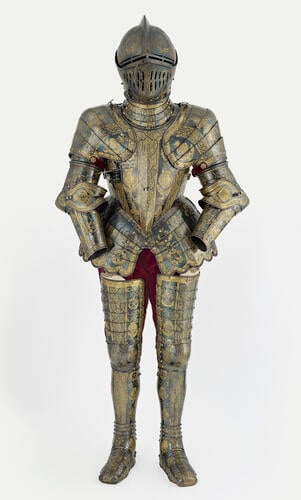
Jacob Halder (active 1576-1608)
Armour garniture of Henry, future Prince of Wales, for the field, tourney, tilt and barriers c. 1608
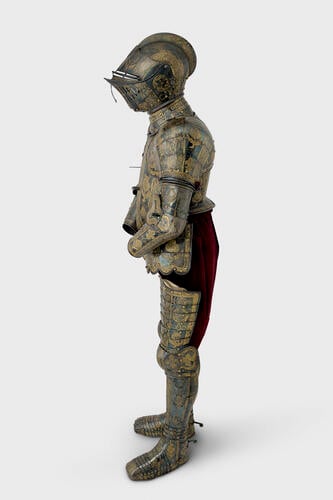
Jacob Halder (active 1576-1608)
Armour garniture of Henry, future Prince of Wales, for the field, tourney, tilt and barriers c. 1608
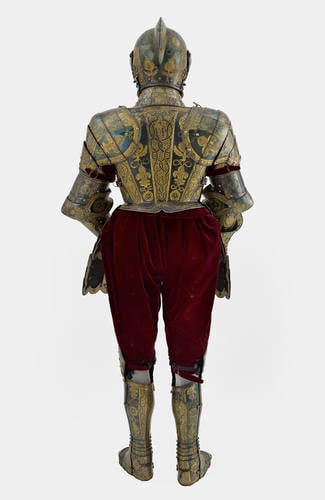
Jacob Halder (active 1576-1608)
Armour garniture of Henry, future Prince of Wales, for the field, tourney, tilt and barriers c. 1608
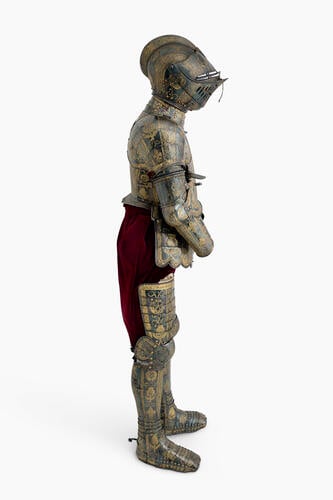
Jacob Halder (active 1576-1608)
Armour garniture of Henry, future Prince of Wales, for the field, tourney, tilt and barriers c. 1608
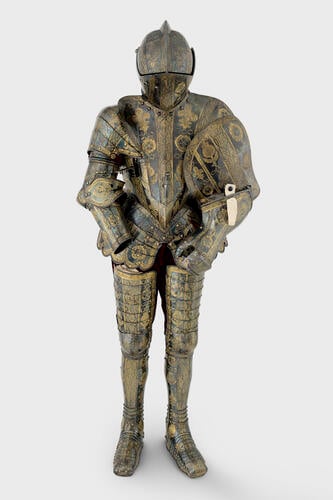
Jacob Halder (active 1576-1608)
Armour garniture of Henry, future Prince of Wales, for the field, tourney, tilt and barriers c. 1608

Jacob Halder (active 1576-1608)
Master: Armour garniture of Henry, future Prince of Wales, for the field, tourney, tilt and barriers c. 1608
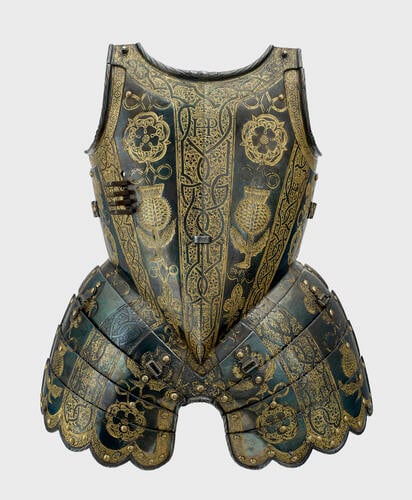
Jacob Halder (active 1576-1608)
Master: Armour garniture of Henry, future Prince of Wales, for the field, tourney, tilt and barriers c. 1608
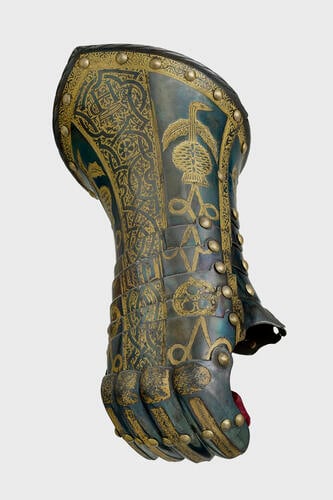
Jacob Halder (active 1576-1608)
Armour garniture of Henry, future Prince of Wales, for the field, tourney, tilt and barriers c. 1608
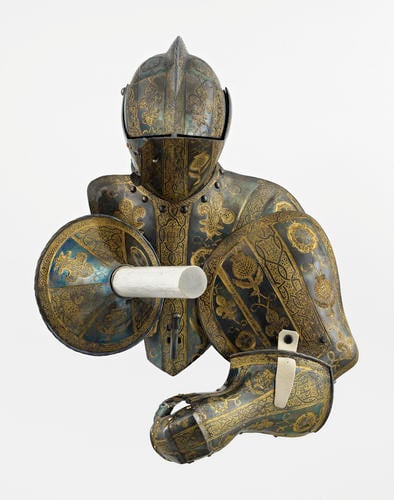
Jacob Halder (active 1576-1608)
Armour garniture of Henry, future Prince of Wales, for the field, tourney, tilt and barriers c. 1608
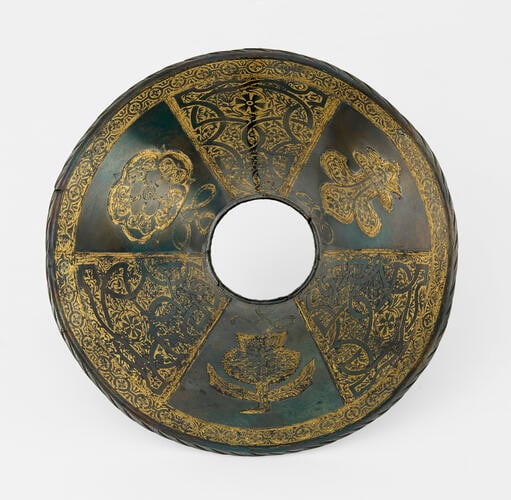
Jacob Halder (active 1576-1608)
Master: Armour garniture of Henry, future Prince of Wales, for the field, tourney, tilt and barriers c. 1608
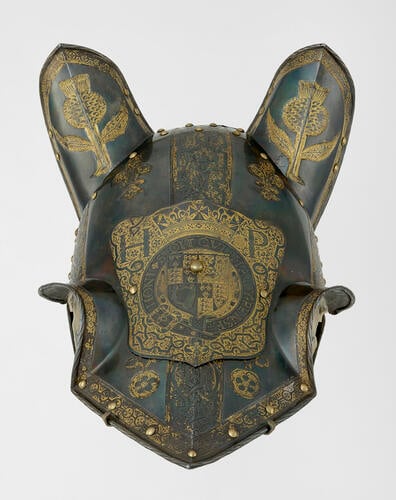
Jacob Halder (active 1576-1608)
Master: Armour garniture of Henry, future Prince of Wales, for the field, tourney, tilt and barriers c. 1608
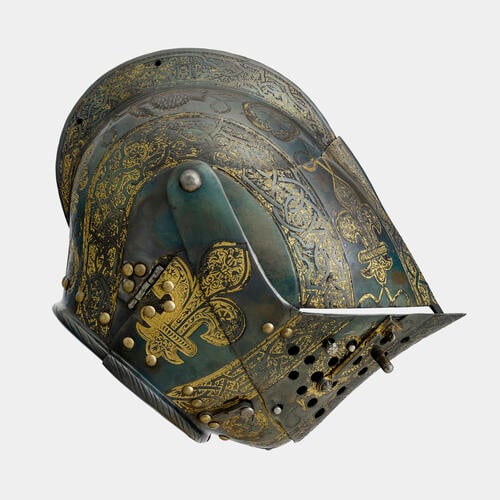
Jacob Halder (active 1576-1608)
Armour garniture of Henry, future Prince of Wales, for the field, tourney, tilt and barriers c. 1608
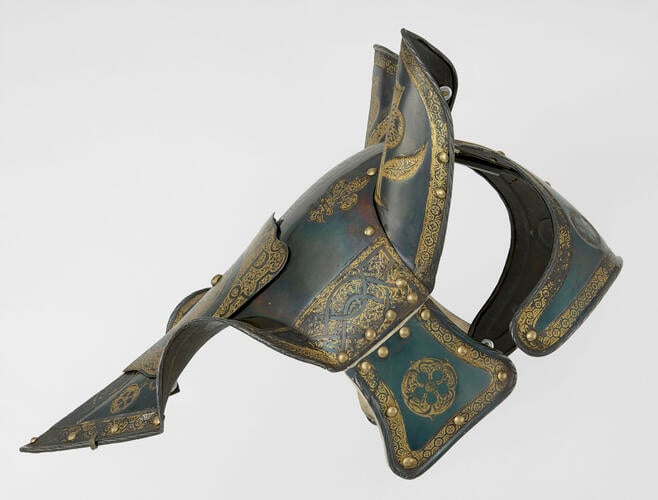
Jacob Halder (active 1576-1608)
Master: Armour garniture of Henry, future Prince of Wales, for the field, tourney, tilt and barriers c. 1608














-
Armour of Henry, future Prince of Wales for the field, tourney, tilt and barriers consisting of a close helmet with reinforces for the upper and lower bevors, a gorget, a cuirass and tassets, a pair of slightly asymmetrical pauldrons, a pair of vambraces and a pair of complete legharness, all for the field; a right half-mitten gauntlet and tasset-extensions, probably for the tourney course; and a second close helmet, a grandguard, a pasguard, a manifer and three vamplates, all for the tilt, together with a half-shaffron for all mounted roles.
The decoration of all elements includes broad recessed bands, etched in relief with blued strapwork formed of two pairs of narrow straps interlaced to form a series of cartouches of various complex shapes amid arabesques involving stylised flower-heads, all on a fire-gilt ground. The topmost cartouche in the principal bands frames the monogram ‘HP’ under the coronet of the Prince of Wales. On each face of the comb of the field helmet the monogram consists of the letters ‘HFP’. The blued surfaces between the bands are formed with recessed fleurs-de-lis, Tudor roses and thistles slipped, all etched: the thistle-heads in a realistic manner and the remainder with arabesques, all on a fire-gilt ground. The inner petals of the roses are blued. Each of the flowers is linked to the next by two narrow ribbons which part to frame a diamond-shaped compartment with a loop projecting from each of the lateral corners.
The turned edges, which have long roping, are mostly followed by narrow recessed borders etched with a series of circles of flat strapwork, each framing a quatrefoil and linked to the next by a short longitudinal bar separating two small opening buds (culots). The edges without turns, for instance those of the tilt reinforces, are followed by a border of moderate width etched like the main bands but with a single wavy line of strapwork; each wave linked to the next by a short straight bar parallel to the edge of the band (jonces coudés). All the original iron fittings of the armour, such as its hinges and swivel-hooks, have been fire-gilt. The hasps, shoulder-straps and tasset-links are all etched with stylised foliage and fire-gilt all over.
Prince Henry is depicted wearing this armour, without its greaves and sabatons, in a posthumous full-length portrait by van Dyck, painted about 1633 (RCIN 404320). The portrait shows that the armour did not have piccadills, that its lining was of a crimson colour and that its straps were covered with purple velvet edged with gold thread. The painting also confirms that all the petals of the roses were originally blued. By 1835 the blueing had been removed, but in 1902 the surfaces were re-blued and later layers of regilding removed. The rivets and articulating-leathers have also been renewed.
Tests undertaken on the skull of the field helmet, the breastplate, the rear plate of the left greave and the pasguard of the armour show them to have microhardnesses in the ranges 289–325 VPH (average 302 VPH), 228–269 VPH (average 252 VPH), 234–325 VPH (average 311 VPH), and 212–236 VPH (average 224 VPH) respectively. The skull and left greave are in each case formed of quenched and tempered steels with very few slag-inclusions. The treatment of both pieces is typical of that found in Greenwich products of the late sixteenth and early seventeenth centuries. The breastplate and pasguard, on the other hand, are formed of medium carbon steels with a few irregular slag-inclusions that have not been quenched and tempered – at least not succesfully. The carbon content of the breastplate is about 0.3–0.4% overall but rises to as much as about 0.8% at some points. It should be noted that re-blueing of this armour in 1902 makes its previous thermal history difficult to deduce unambiguously.
Text adapted from Norman, A.V.B, & Eaves, I. 2016. Arms and Armour in the Collection of Her Majesty The Queen: European Armour, London.
Metallurgy by Williams, A, & Metcalf, S. 2016. Summary of the metallurgy of European Armour in the Royal Collection. London. Appendix II of Norman & Eaves
Measurements: Field Helmet: height 24.5 cm, width 20.7 cm, depth 33.0 cm; Upper Reinforcing Bevor: height 14.0 cm, depth 20.0 cm; Lower Reinforcing Bevor: height 15.9 cm, depth excluding the hasps 12.7 cm; Tilt Helmet: height 24.8 cm, width 20.3 cm, depth 32.4 cm; Gorget: height 21.3 cm, internal diameter of neck-opening 14.8 cm; Breastplate: fauld and tassets, height from shoulders to centre of waist 45.6 cm, height from centre of neck to lower edge of breastplate 37.5 cm, height from centre of neck to lower edge of skirt 40.4 cm, height from shoulders to lower edge of tassets 55.3 cm, width beneath arm-openings 31.9 cm, width at waist 24.9 cm, width at lower end of tassets 48.8 cm, height of each tasset 17.8 cm; width of each tasset 24.2 cm, height of each tasset-extension: height 15.9 cm, width of each tasset-extension 22.9 cm; Lance-Rest: height of base plate 0.5 cm, width of base plate 5.1 cm; backplate: height 35.6 cm; Right Pauldron: height 23.5 cm, width 19.7 cm; Left Pauldron: height 23.5 cm, width 19.7 cm; Right Vambrace: length 45.1 cm; Left Vambrace: length 45.1 cm; Tourney Gauntlet: length 30.5 cm; Right Legharness: height of cuisse and poleyn 33.3 cm, height from top of cuisse to centre of knee 27.9 cm, height from centre of knee to ground 42.6 cm, height of greave and sabaton 39.4 cm, length of foot 25.1 cm; Left Legharness: height of cuisse and poleyn 33.7 cm, height from top of cuisse to centre of knee 27.9 cm, height from centre of knee to ground 42.6 cm, height of greave and sabaton 39.4 cm, length of foot: 25.1 cm; Grandguard: height 54.6 cm, width 47.7 cm; Pasguard: height 39.1 cm, width 30.5 cm; Manifer: length 38.8 cm, width 19.1 cm; First Vamplate: external diameter 25.4 cm, depth 11.5 cm, diameter of aperture 5.7 cm; Second Vamplate: external diameter 25.4 cm, depth 11.8 cm, diameter of aperture 5.7 cm; Third Vamplate: external diameter 28.1 cm, depth 11.8 cm, diameter of central aperture 5.7 cm; Shaffron: height 36.2 cm, width 19.7 cm.
Weight: Field Helmet: 2.41 kg; Upper Reinforcing Bevor: 0.184 kg; Lower Reinforcing Bevor: 0.347 kg; Tilt Helmet: 2.665 kg; Gorget: 1.049 kg; Breastplate and Tassets without Lance-Rest and Retaining-Pin: 4.111 kg; Lance-Rest and Retaining-Pin: 0.170 kg; Right Tasset-Extension: 0.442 kg; Left Tasset-Extension: 0.428 kg; Lance-Rest: 0.142 kg; Retaining-Pin of Lance-Rest: 0.028kg; Backplate: 1.304 kg; Right Pauldron: 0.99 kg; Left Pauldron: 0.998 kg; Right Vambrace: 1.304 kg; Left Vambrace: 1.304 kg; Tourney Gauntlet: 0.595 kg; Right Legharness: 2.1 kg; Left Legharness: 2.25 kg; Grandguard: 2.778 kg; Pasguard: 1.474 kg; Manifer: 0.936 kg; First Vamplate: 0.708 kg; Second Vamplate: 0.634 kg; Third Vamplate: 0.646 kg; Shaffron: 1.871 kg.
Provenance
Since the decoration of this armour does not include the badge of the Prince of Wales, it must have been made before Prince Henry’s (1594-1612) creation on 4 June 1610. It was in fact given to him by Sir Henry Lee (1533-1611), Champion to Elizabeth I from about 1570 to 1590 and Master of the Armouries from 1580 until the time of his death. In a letter of September 1608, Lee is described as having gone 'this Summer... to present the Prince wth an armor that stoode him in £200'.
The Prince held his first formal barriers in the Banqueting House at Whitehall on Twelfth Night 1610. For the event, he would have worn the field helmet of this garniture, accompanied by its gorget, cuirass with short tassets and complete arm-defences. Prince Henry is known to have particularly enjoyed military sport and it was said of him that he would often 'run at the ring and sometimes at tilt, both which he performed with so much dexterity and skill, that he became second to no Prince in Christendom, and superior to most of those persons, who practised with him’.
Because the armour was formerly thought to have been made about 1610, it was attributed to William Pickering (d. 1618), who had become Master Workman of the Almain Armouries at Greenwich on 16 March 1608, following the death of his predecessor, Jacob Halder (Master 1576–1608). It now seems probable that work had started on it, even if it had not been completed, during the final year of Halder’s regime.
The armour may perhaps be the ‘Tilte armor guilte compleate made for the Prince’ which is listed at Greenwich in ‘the greate Chamber at Mr Pickerings’ in the 1611 Remain. It referred to in the 1629 Remain as: ‘One other guilte and graven Tilte and feild Armor Compleate excepting field headpeece one Poldron one Vambrace, one Gauntlett and one Vamplett given by Sr Henry Lee to Prince Henry'. Subsequently it was one of the armours rescued from Greenwich by Edward Annesley about 1644.
In the 1650 Remain it was almost certainly the ‘Guilt Armor in ye 4th Trunk’ since this is a tilt armour with two headpieces and three vamplates. In the 1660 Remain it is probably to be identified among the ‘Sundry Compleate Armors and others whereof some of them were standing formerly at Greenwich in the green Gallery there … Upon a Horse Statue of Wood, One compleat Tilt Armor cap a pe richly gilt, part engraven, part Damasked, made for Prince Henry with two Gauntletts and one gilt grandguard the Horse ffurniture being one Shaffron of the same sort one old Leather Sadle and Bitt’. This entry is repeated almost word for word in the Inventory of 1675–9, but does not occur in the 1682 Survey, possibly because the armour had been sent to another palace. In 1688, when this armour was once more in the Tower, it was valued at £208. It was still there at the end of 1692.
Most of the parts making up the armour were included as no. 2 in the second group of pieces recorded correctly in the manuscript ‘An Account of the Armour and Arms in the Guard Chamber at Windsor Castle’, prepared by the Board of Ordnance at the Tower of London, and dated 29 July 1831 (Appendix IV). It appears that one gauntlet, a pair of ‘Jambiers’ and a pair of ‘Sollerettes with Spurs’ (i.e. greaves and sabatons), and a ‘Burgonet Helmet, extra’ were all supplied from the Tower for the redisplay. -
Creator(s)
(nationality)Acquirer(s)
-
Medium and techniques
Hardened and tempered steel, blueing, gold, leather.
Category
Object type(s)
Other number(s)
Alternative title(s)
Armour of Henry, Prince of Wales for the field, tourney, tilt and barriers
Place of Production
Greenwich [London]